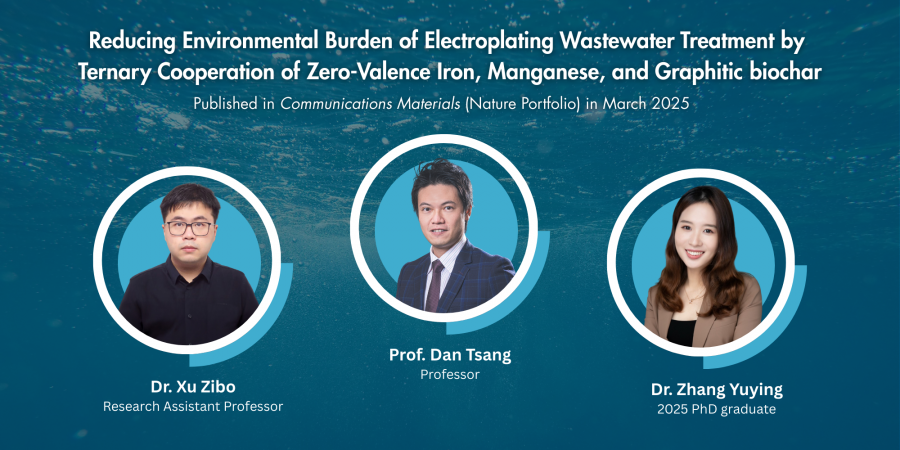HKUST Engineering Researchers Pioneer Breakthrough to Clean Toxic Electroplating Wastewater with Reduced Carbon Footprint
A research team led by Prof. Dan TSANG, Professor of the Department of Civil and Environmental Engineering at the Hong Kong University of Science and Technology (HKUST), has developed a biochar-based material that simultaneously tackles toxic industrial wastewater and climate emissions. Their innovation addresses a critical environmental challenge: cleaning electroplating wastewater, a toxic byproduct of manufacturing a wide array of products from consumer electronics to automobiles, without worsening the carbon crisis.
The dual challenge for electroplating wastewater treatment
Electroplating, essential for creating shiny, corrosion-resistant surfaces on metal products, generates a staggering 4 billion tons of heavily contaminated wastewater annually in China alone. This wastewater contains dangerous levels of chromium, nickel, copper, and zinc—metals that can poison water, soil, and food chains.
Traditional treatment methods rely on iron-based chemicals to trap these toxins. However, this approach has hidden costs: it consumes massive amounts of energy, requires harsh chemicals, and produces hazardous sludges that must undergo carbon-intensive stabilization (such as solidification with cement or high-temperature incineration) before being disposed of in a landfill. The combined footprint makes wastewater treatment part of the pollution problem it aims to solve.
Design of biochar-based materials for the simultaneous reduction of toxic elements and carbon emissions
The HKUST team’s solution, engineered biochar, combines three simple components into an innovative, self-contained cleanup system:
- Reactive iron particles act as “electron donors” to reduce toxic elements from soluble ions to insoluble metals (i.e., from a form that can dissolve in water to a form that cannot), making the toxic elements easier to trap
- Manganese oxides trap contaminants after reduction
- Engineered biochar forms a protective graphite shield around the iron to prevent passivation (the process where the iron gets covered with a layer that stops it from being effective) and stabilizes the mineral particles
All these processes were supported by combining experimental, modeling, and characterization evidence.
The magic lies in how these components interact. During production, a unique hydrothermal process embeds the iron and manganese deep inside the biochar’s structure. The graphite coating prevents iron passivation, a major bottleneck in conventional methods, allowing it to work more efficiently. Meanwhile, manganese oxides undergo atomic-level expansion, enhancing their capacities to capture pollutants.
“Think of it as a synergy impact from three-party cooperation,” explains Prof. Tsang. “The biochar shields the iron from passivation and supports the electron transfer, the lattice-expanded manganese oxide locks toxins in place, and everything binds together within graphitic carbon to eliminate secondary waste.”
Climate and industry impact
The proposed materials can achieve nearly 90% lower carbon emissions compared to conventional treatment, according to calculations. It can also gain other potential advantages, such as lower land usage and water consumption, resulting from reduced chemical consumption. If implemented in China, this technology could prevent 0.75 million tons of carbon dioxide equivalent (CO2eq) annually, an assumption based on the annual electroplating wastewater discharge in China.
A template for industry pollution control
This technology is not limited to electroplating wastewater but can be applied to a wide range of industries, including those struggling with metal-laden sewage, such as mining operations, tanneries, and battery manufacturers. “This isn’t just for electroplating, it’s a blueprint for cleaning industrial pollution sustainably,” Prof. Tsang added. It turns pollution control from a carbon liability into a climate-smart process. The team has already demonstrated the capacity of the as-prepared biochar-based materials to remove a variety of toxic elements and organic pollutants, indicating their potential for a broad spectrum of wastewater treatment applications.
Global collaboration
HKUST’s biochar research is actively advancing from lab-scale discovery to industrial translation. Led by Prof. Tsang, the team’s findings were published in Communications Materials, a journal from Nature Portfolio, in a paper titled “Reducing environmental burden of electroplating wastewater treatment by ternary cooperation of zero-valence iron, manganese, and graphitic biochar”.
Co-authors include Dr. XU Zibo (first author), Prof. Tsang’s PhD graduate and currently Research Assistant Professor in the same department; Dr. ZHANG Yuying (Prof. Tsang’s PhD graduate); as well as collaborators from Imperial College London (UK), Shanghai Jiao Tong University (China), University of Wuppertal (Germany), University of California, Davis (US), and Korea University.



